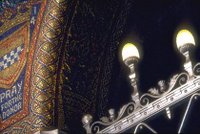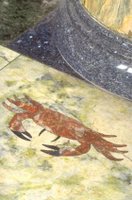St Andrew, brother of Simon Peter
 The mosaic of St Andrew, from his chapel, heralds his feast day. The chapel of St Andrew fittingly contains many Scottish elements, and granite from Scotland is used in decoration, but it is as patron of Greece that his memory is most honoured, in this most thoroughly Byzantine of all our chapels. The shimmering mosaic of the ceiling, the furniture closely modelled on byzantine originals - even the ostrich egg (symbol of perfection) enclosed in the chandelier, all breathe the spirit of Byzantium.
The mosaic of St Andrew, from his chapel, heralds his feast day. The chapel of St Andrew fittingly contains many Scottish elements, and granite from Scotland is used in decoration, but it is as patron of Greece that his memory is most honoured, in this most thoroughly Byzantine of all our chapels. The shimmering mosaic of the ceiling, the furniture closely modelled on byzantine originals - even the ostrich egg (symbol of perfection) enclosed in the chandelier, all breathe the spirit of Byzantium. However, Scotland is recalled in various details, including the thistles decorating the top of the screen, and the names of Scottish saints engraved around the walls. The mosaic image of the town of St Andrews is included in the depictions of locations relating to the saint's relics; they also include Patras (whither Pope Paul VI returned his head), and Amalfi, where the remainder of his body exudes (so I was told when visiting) an oil used to anoint pregnant women! In this chapel, relics of the saint are housed in a celtic cross just above the altar.
However, Scotland is recalled in various details, including the thistles decorating the top of the screen, and the names of Scottish saints engraved around the walls. The mosaic image of the town of St Andrews is included in the depictions of locations relating to the saint's relics; they also include Patras (whither Pope Paul VI returned his head), and Amalfi, where the remainder of his body exudes (so I was told when visiting) an oil used to anoint pregnant women! In this chapel, relics of the saint are housed in a celtic cross just above the altar.
 St Andrew was, of course, a fisherman from Bethsaida, before being called to follow the Lord. His trade is recalled in the marble pattern on the floor, depicting a flowing river and, alongside it, river and sea creatures.
St Andrew was, of course, a fisherman from Bethsaida, before being called to follow the Lord. His trade is recalled in the marble pattern on the floor, depicting a flowing river and, alongside it, river and sea creatures.
Lord, we pray for the people of Scotland
Bless them with peace and prosperity.
Help us all, like St Andrew,
To hear Jesus' call to be his disciple,
And to make his gospel known in our world.

No comments:
Post a Comment